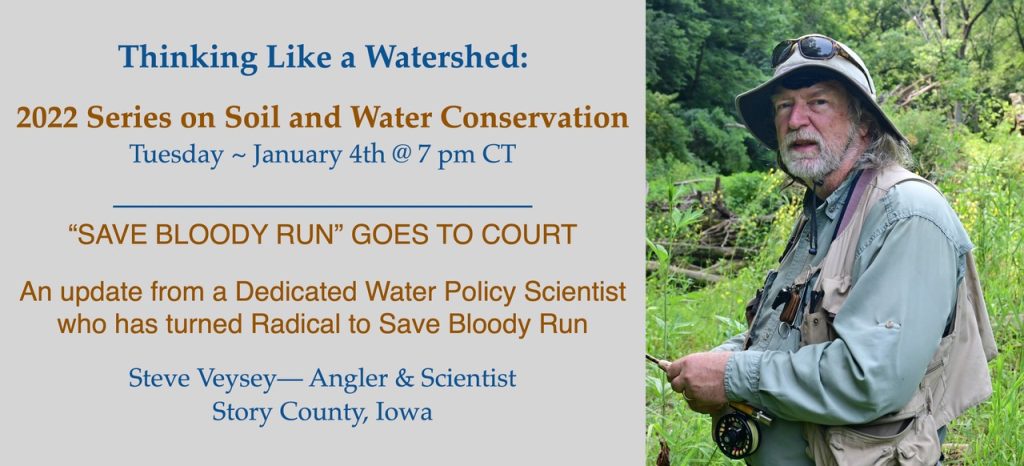The year that was…
My Iowa colleagues have captured my imagination with their call for “a great clamoring,” which is, perhaps, a way to sum up our fervent fight for “together” in 2021. Because despite the pandemic, we managed to carve out substantial accomplishments in a community fashion, together in purpose. Yes, that, but also streamside, farmers market-side, Zoom-side, lake park bench-side, and occasionally – post-vaccinations -, café-side for some energetic planning with a purpose.
Taken together, here are some highlights to consider as we all turn the page on another year. But first….
“Thinking Like a Watershed” Tuesday, Jan.4 as Bloody Run goes to court
Our monthly web presentations starts anew at 7 p.m. Central with a critical update on the fight for the health of one of Iowa’s pristine waters threatened with a 11,600-head confinement beef operation. Do I have your attention? Here is the link to join this 30-minute presentation on the almost-eve of the Jan. 6 court date.

Photo by: David Thoreson
Steve will fill us in on the details of Supreme Beef’s facility and their blatantly flawed Nutrient Management Plan. The feedlot expansion is sited in Iowa’s delicate karst topography and evidence suggests that state officials, elected and otherwise, are facilitating an environmental pass that will result in the degradation of Bloody Run. If we can’t SAVE Bloody Run, a state – designated outstanding water, is there any hope for water quality in Iowa and beyond?
Besides being an avid angler, Steve has an extensive background in water quality policy issues. He retired from Iowa State University as the manager of the Chemical Instrumentation Facility and has spent the past 25 years working to improve water quality in Iowa. He is best known for efforts related to development and implementation of proper Clean Water Act standards for Iowa. He brings a strong science background and a willingness to understand “the devil in the details” of water quality standards and AFO regulations.
A Great Clamoring of 2021
We do this work with our partners to date
Cannon River Watershed Partnership
Dairy Grazing Apprenticeship
IWLA chapters in Winona, Austin, Owatonna
Land Stewardship Project
League of Women Voters/Upper Mississippi River Region (UMRR)
Midwest Perennial Forage Working Group/Green Lands Blue Waters and all collaborators
National Trout Center
Sustainable Farmers Association of Minnesota
universities – University of MN, Minnesota State College Southeast, Winona State University, St. Mary’s
University of Minnesota
Winona Farmers Market
UMRI-generated Accomplishments
❖ Save Our Streams (SOS) stream teams – training, monitoring site selection, and team organization in collaboration with local partners and the national IWLA program; expanded (8) monitoring sites, kit upkeep, team coordination, Clean Water Hub data, citizen science at work.
❖ Water/Public engagement – SOS to the Winona Farmers Market for hands-on education and palpable synergy between SOS and the Winona Will Dilg chapter via an Endowment grant.
❖ Water Quality Monitoring with a Purpose – Weekly summer sampling project in the Iowa reaches of the Cedar River Watershed to conduct an E. coli source survey after training by the Austin chapter; human fecal matter was identified by DNA analysis at 2 of 20 sites monitored by 3 teams from 3 county chapters plus students and some resource agents. An Endowment grant by Minnesota and in-kind staffing by UMRI provided all supplies and UMRI staff and Austin leaders wrote the training protocol and final report. The methods and results are finding “legs” at national and state levels.
❖ “Thinking Like a Watershed” – web series to give voice to critical local issues during monthly online presentations open to all; chiefly organized by Iowa UMRI staff with assistance from and co-organization by Minnesota staff. It draws a national audience. See above for the 2022 start on Jan. 4 at 7 p.m. Central.
❖ Publications on soil, water, grazing, conservation – 2 publications co-written as part of the Midwest Perennial Forage Working Group a part of Green Lands Blue Waters, the peer-reviewed article and this infographic on “Perennial Forage for Infrastructure Protection.”
❖ Movement in the Minnesota River Basin to successfully challenge ditch drainage projects on grounds of water quality and quantity concerns.

“Severe storms don’t have to take out our roads and culverts. This infographic is available for sharing widely with county and township officials, Extension educators, and other agriculture agents who face erosion issues in need of fixing or better, preventing”
Getting Started in 2022
❖ Build on SOS monitoring sites, team participation, public education to add data and citizen science engagement to water protection campaigns
❖ Build a water- and soil-driven partnership in the Driftless Area of Minnesota
❖ Collaborative work with newly revived Will Dilg chapter
❖ Non-operating landowner series (virtual) in partnership with UMRI Iowa staff
❖ Active organizing of “Thinking Like a Watershed” web series in collaboration with UMRI Iowa staff
❖ Minnesota River Basin collaborations to address the process and reality of ditch drainage proposals.
